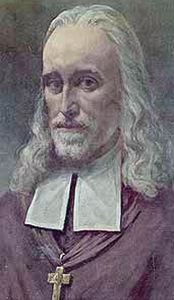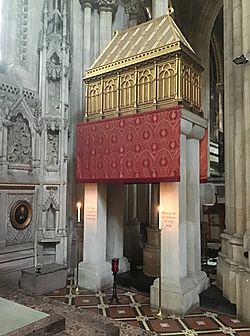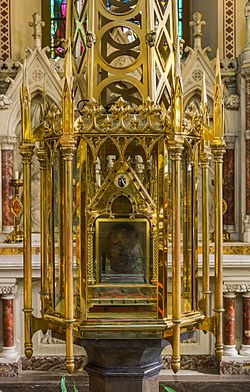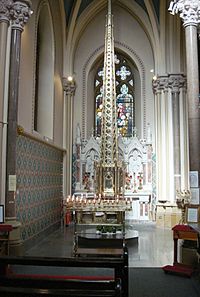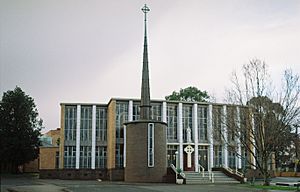Oliver Plunkett facts for kids
Quick facts for kids Saint Oliver Plunkett |
|
|---|---|

Oliver Plunkett in a portrait by Edward Luttrell
|
|
| Martyr, Archbishop and Primate of All Ireland | |
| Born | 1 November 1625 Loughcrew, County Meath, Ireland |
| Died | 1 July 1681 (aged 55) Tyburn, London, England |
| Venerated in | Catholic Church |
| Beatified | 23 May 1920, Rome by Pope Benedict XV |
| Canonized | 12 October 1975, Rome by Pope Paul VI |
| Major shrine | St. Peter's Roman Catholic Church, Drogheda, Ireland |
| Feast | 1 July |
| Patronage | Peace and reconciliation in Ireland |
Oliver Plunkett (born November 1, 1625 – died July 1, 1681) was an important leader in the Catholic Church in Ireland. He was the Archbishop of Armagh and the top Catholic leader in all of Ireland. He was also the very last person to be executed because of something called the Popish Plot.
Oliver Plunkett was made a "Blessed" (beatified) in 1920. Later, in 1975, he became a "Saint" (canonised). He was the first new Irish saint in nearly 700 years!
Oliver Plunkett's Life Story
Oliver Plunkett was born in a place called Loughcrew, in County Meath, Ireland. His family was quite well-off. He was born on November 1, 1625. His family had connections to important Irish families like the Earls of Fingall.
Early Education and Priesthood
When Oliver was a boy, his cousin, Patrick Plunkett, taught him. Patrick was an abbot, which is a leader in a monastery. Oliver wanted to become a priest. So, in 1647, he traveled to Rome, Italy.
At that time, Ireland was going through tough times with wars. These wars were between Irish Catholics and English Protestants. Because of the fighting, Oliver couldn't go back to Ireland for many years. He stayed in Rome and became a professor of theology, which is the study of religious beliefs.
He was ordained as a priest in 1654. This means he officially became a priest. He worked hard to represent the Irish Catholic Church in Rome.
Returning to Ireland
In 1669, Oliver Plunkett was chosen to be the Archbishop of Armagh. This was a very important role. He was consecrated (made an archbishop) in Ghent on November 30, 1669. He finally returned to Ireland on March 7, 1670.
When he got back, he worked to improve the Catholic Church in Ireland. He wanted priests to be good examples. He even started a Jesuit College in Drogheda in 1670. This college was special because it welcomed both Catholic and Protestant students. It was one of the first schools in Ireland to do this! Oliver Plunkett was very successful in his work. He confirmed over 48,000 Catholics in just four years.
The Popish Plot and Unfair Trial
Life became difficult for Catholics in Ireland again in the 1670s. Laws against Catholics were made stricter. Oliver Plunkett's college had to close down. He had to go into hiding and travel in disguise.
The False Accusations
In 1678, a false story called the "Popish Plot" started in England. A man named Titus Oates made up lies about Catholics planning to harm the King and invade England. This led to more actions against Catholics.
Oliver Plunkett was accused of plotting to bring French soldiers to Ireland. He was also accused of raising money for a rebellion. These accusations were not true. Many people, including the Duke of Ormonde, who was in charge of Ireland, knew the accusations were false. The Duke called the people making the accusations "silly drunken vagabonds."
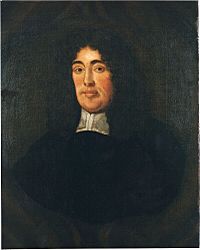
His Trial in London
Oliver Plunkett was arrested in Dublin in December 1679. He was first tried in Ireland, but the trial stopped because the people accusing him were afraid to show up.
So, Oliver Plunkett was moved to Newgate Prison in London, England. He was tried again at Westminster Hall. This second trial was very unfair. He wasn't allowed to have a lawyer to defend him properly. He also wasn't given enough time to gather witnesses and evidence to prove his innocence.
The judge, Sir Francis Pemberton, didn't listen to Oliver Plunkett's complaints. Many people, even at the time, believed he was innocent. A Scottish clergyman named Gilbert Burnet said Oliver Plunkett was a wise and calm man who only wanted to live peacefully. Later, a judge named Sir James Comyn called the trial a "grave mistake."
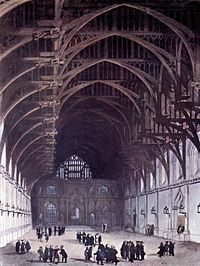
Execution and Legacy
Despite pleas for mercy, Oliver Plunkett was found guilty of treason in June 1681. The judge said he was guilty for "promoting the Roman faith." Oliver Plunkett replied, "Deo Gratias" (which means "Thanks be to God" in Latin).
King Charles II knew Oliver Plunkett was innocent. However, he felt it was too risky to pardon him because of the political situation. So, Oliver Plunkett was sentenced to death.
His Final Moments
Oliver Plunkett was executed at Tyburn, London on July 1, 1681. He was 55 years old. He was the last Catholic to die as a martyr in England.
After his death, his body was first buried in London. Later, his remains were moved to a monastery in Germany. His head was brought to Rome, then to Armagh, and finally to Saint Peter's Church in Drogheda, Ireland, where it rests today. Most of his body is now at Downside Abbey in England.
Becoming a Saint
Oliver Plunkett was declared a "Blessed" in 1920 and a "Saint" in 1975. He was the first new Irish saint in almost 700 years! He is now known as a patron saint for peace and reconciliation in Ireland.
In 1981, a large gathering and Mass were held in London to celebrate 300 years since his martyrdom. Thousands of people came to honor him.
Places Named After Saint Oliver Plunkett
Many places are named after Saint Oliver Plunkett to honor his memory.
Religious Sites
- St. Oliver Plunkett Church in County Antrim
- St. Oliver Plunkett Church in Mungret, Limerick
- St. Peter's Catholic Church in Drogheda, County Louth (where his head is kept)
- Shrine at Loughcrew, County Meath (his birthplace)
- Downside Abbey, Somerset, England (where most of his body rests)
- St. Oliver Plunkett Catholic Church in Snellville, Georgia, USA
- St. Oliver Plunkett's Parish in Cannon Hill, Queensland, Australia
Schools
- St. Oliver Plunkett's Post Primary School in Oldcastle, County Meath
- Scoil Oilibhéir SN in Dublin
- St. Oliver Plunkett Primary School in Beragh, County Tyrone
- St. Oliver Plunkett National School in Blackrock, County Louth
- St. Oliver Plunkett School in Belfast, County Antrim
- Downside School, Somerset, England
- St. Oliver Plunkett Primary School in Harris Park, New South Wales, Australia
Sports Clubs and Places
- St. Oliver Plunkett Park in Crossmaglen, County Armagh
- Oliver Plunketts GAA in Drogheda, County Louth
- St Oliver Plunketts/Eoghan Ruadh GAA in Dublin
- Oliver Plunkett Cup for the Cavan Senior Football Championship
Other Places
- Oliver Plunkett Street in Cork City, County Cork
- St. Oliver Plunkett Road in Letterkenny, County Donegal
- St. Oliver Plunkett's Bridge in County Offaly
- Oliver Plunkett Avenue in Monkstown, County Dublin
An Aer Lingus plane is also named after him!


